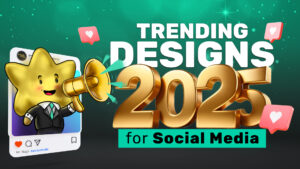Subliminal elements in a logo are subtle design features, symbols, or messages intentionally hidden within the logo’s design, not immediately evident upon initial inspection. These concealed elements are inserted to convey a secondary or deeper meaning.
What is a subliminal in a logo?
A common question asked by people who are looking to give their brand an identity.
Subliminal elements in a logo are hidden as subtle design features, symbols, or messages that are not immediately obvious to the viewer at first glance. These elements are intentionally incorporated into the logo design to convey a secondary meaning or message to those who pay close attention or analyze the logo more deeply.
The history of subliminal messaging in logos dates back to the mid-20th century when it gained fame in the 1950s and 1960s amid concerns that advertisers were employing hidden messages to influence consumer behavior. These suspicions led to various studies and investigations into the phenomenon.
The effectiveness of subliminal messages in logos and advertising remains a topic of debate. While some studies have suggested that subliminal messages may have a limited impact on behaviour or perception, the results are inconclusive, and opinions on their influence differ.
How do we create them?
Designers employ various techniques to create subliminal messages in logos. Negative space, which refers to the area surrounding and between the main elements of an image, is cleverly manipulated to form shapes and symbols that convey hidden messages or create visual intrigue within the logo.
Advertisers employ subliminal messages as a psychological marketing technique to subtly influence consumer behaviour and perception. These concealed messages aim to shape consumer choices, decisions, and brand preferences without the viewer consciously realizing it. They can be utilized to promote a product, encourage brand loyalty, or boost sales.
Lets look at some of notable logos that have subliminal messaging

FedEx: The FedEx logo is famous for the hidden arrow created by the negative space between the “E” and “x.” This arrow symbolises speed and forward motion.

Amazon: The Amazon logo features a smile that goes from the letter “a” to “z,” subtly indicating that they have everything from A to Z.

Toblerone: The Toblerone logo contains a hidden bear in the mountain design, representing the Swiss origins of the chocolate brand. The bear is associated with the city of Bern.

Baskin-Robbins: The Baskin-Robbins logo has the number “31” incorporated into the letter “B” and “R,” signifying their famous 31 flavors of ice cream.

Toyota: Some interpretations suggest that the three ovals in the Toyota logo represent the company’s vision to unite the hearts of its customers and the company itself.

Unilever: The Unilever logo is known for its hidden symbols representing different aspects of the company’s diverse product range, including a heart (for love), a bird (for freedom), and more.

Gillete — Look closely at the “G” and the “i” in this logo and you’ll notice the razor-sharp cuts into the text, which represents the shaving brand’s main product.

Beats — The “b” in the beats logo is mean to look like someone wearing headphones.

LG — The electronics company managed to create a winky face out of ‘L’ and ‘G”.10. Hyundai: The 10.

Hyundai: logo symbolises a handshake between the company and its customers, with two stylized “H’s.”
In the realm of logo design, the art of negative space is often underestimated but holds incredible potential. It adds depth, intrigue, and memorability to a brand’s visual identity. Cleverly using negative space can transform a logo into more than just an image; it becomes a story, a conversation starter, and a lasting memory in the minds of consumers. Therefore, when designing or analysing logos, paying close attention to the spaces in between may unveil the most about a brand’s identity.





